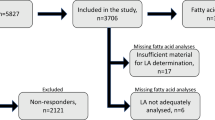Abstract
Objective: We examined the reliability of the fatty acid composition of serum phospholipids in the New York University Women’s Health Study, a prospective study of sex hormones, diet and breast cancer.
Design: Non-fasting serum samples collected at three yearly visits, in 46 healthy women, and stored at −80°C for 7–12 y, were included in the study. Serum phospholipid fatty acid composition was measured by capillary gas chromatography.
Results: For the 20 individual fatty acids measured, the reliability coefficients were less than 0.50 for four, between 0.50 and 0.70 for nine, and greater than 0.70 for seven. Among the major fatty acids, arachidonic and α-linolenic acids had high reliability coefficients (0.71 and 0.72, respectively), palmitic, oleic, linoleic, eicosapentaenoic and docosahexaenoic acids had intermediate coefficients (0.57, 0.69, 0.62, 0.64 and 0.66, respectively), whereas stearic acid had the lowest coefficient (0.15). The reliability coefficients for total monounsaturated fats, omega-6 and omega-3 fatty acids were moderately high (0.66, 0.53 and 0.66, respectively), whereas the coefficients for total saturated fats and total polyunsaturated fats were low (0.31 and 0.43, respectively).
Conclusions: These results indicate that the fatty acid composition of serum phospholipids can be a useful tool in epidemiologic studies, although for most fatty acids a single determination is associated with some error in measurement that should be taken into account at the design and analysis stages. Storage for up to 12 y at −80°C preserved polyunsaturated fatty acids from oxidation very well.
European Journal of Clinical Nutrition (2000) 54, 367–372
This is a preview of subscription content, access via your institution
Access options
Subscribe to this journal
Receive 12 print issues and online access
$259.00 per year
only $21.58 per issue
Buy this article
- Purchase on Springer Link
- Instant access to full article PDF
Prices may be subject to local taxes which are calculated during checkout
Similar content being viewed by others
Author information
Authors and Affiliations
Contributions
Guarantor: A Zeleniuch-Jacquotte.
Contributors: A Zeleniuch-Jacquotte designed the study, selected the samples to be assayed and conducted the statistical analysis. V Chajes developed the assay methodology and supervised the conduct of the assays. AL van Kappel was in charge of the preperation of the samples.
E Riboli and P Toniolo had the original idea of the study. P Toniolo provided the serum samples which were analyzed in E Rinoli’s laboratory. All authors contributed to the writing of the paper.
Corresponding author
Rights and permissions
About this article
Cite this article
Zeleniuch-Jacquotte, A., Chajès, V., Van Kappel, A. et al. Reliability of fatty acid composition in human serum phospholipids. Eur J Clin Nutr 54, 367–372 (2000). https://doi.org/10.1038/sj.ejcn.1600964
Received:
Revised:
Accepted:
Published:
Issue Date:
DOI: https://doi.org/10.1038/sj.ejcn.1600964
Keywords
This article is cited by
-
DHA status influences effects of B-vitamin supplementation on cognitive ageing: a post-hoc analysis of the B-proof trial
European Journal of Nutrition (2022)
-
Associations between fatty acids and low-grade inflammation in children from the LISAplus birth cohort study
European Journal of Clinical Nutrition (2017)
-
A prospective study of erythrocyte polyunsaturated fatty acid, weight gain, and risk of becoming overweight or obese in middle-aged and older women
European Journal of Nutrition (2016)
-
Body mass index, gestational weight gain and fatty acid concentrations during pregnancy: the Generation R Study
European Journal of Epidemiology (2015)
-
Association between erythrocyte membrane fatty acids and biomarkers of dyslipidemia in the EPIC-Potsdam study
European Journal of Clinical Nutrition (2014)



